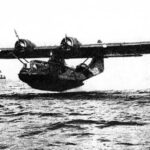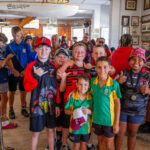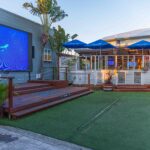{^widget|(caption)Bowen%27s+RAAF+Catalina+Flying+Boat+Base+during+WWII|(name)FullWidthImageWithCaption|(imageurl)%7e%2fGrandViewHotel%2fmedia%2fGrand-View-Hotel-Image-library%2fbowenfbb04.jpg%3fext%3d.jpg|(widget_displayname)Full+Width+Image+With+Caption|(width)|(height)^}
Bowen played an important part in Australia’s WWII efforts by providing a base for the Catalina flying boats of the Royal Australian Air Force.
The Catalina Flying Boat is a fixed wing seaplane with a hull, allowing it to land on water. Its role was a maritime patrol and search-and-rescue seaplane, anti-submarine warfare, fire-bombing and surveying. In peace time, it was used for charter, exploration and fire bombing. A ‘Flying Boat’ is an aircraft that can take off and land on water.
The earlier models had wheels that were detached after the aircraft entered the water, with the later models being amphibious and able to land on water and then extend the landing gear to taxi onto land or land at conventional airports or airstrips.
Between 1942 and 1945 Bowen was used as an operational base for the Catalinas of RAAF Squadron 11, 20 and 43. The Squadrons flew north on reconnaissance and bombing missions around New Guinea and New Britain, and later as a maintenance base.
{^widget|(caption)Catalinas+in+flight|(name)FullWidthImageWithCaption|(imageurl)%7e%2fGrandViewHotel%2fmedia%2fGrand-View-Hotel-Image-library%2fr1450387_21068663.jpg%3fext%3d.jpg|(widget_displayname)Full+Width+Image+With+Caption|(width)|(height)^}
During the war years, Bowen was very much an air force town. For periods, the Catalina flying boats were headquartered at Bowen, before later moving to Cairns. The first association with Bowen and the Catalina flying boats reaches back to around 1926-7 with the Supermarine Seagull 111 bi-planes being used to provide aerial photography over parts of the Great Barrier Reef.
The Catalina fleet then commenced what is known as the ‘Milk Run’ – missions that formed the forerunners of many allied attacks on the Japanese fleet in the Coral Sea. Flying under the cover of darkness, the Catalina’s were given the nickname of ‘Black Cats’, and a common cry was ‘The Black Cats are flying tonight!’
KEY FACTS
The aircraft was usually equipped with:
- 3 x .30 calibre (7.62mm) Machine Guns (2 x in Nose Turrets, 1 x in Ventral Hatch at Tail)
- 2 x .50 calibre (12.7mm) Machine Guns (1 x in each Waist Blister)
- 4,000 lb (1,814 kg) of Bombs or Depth Charges
- Some also had Torpedo Racks
It requires a crew of 8 – 10 people which include:
- Pilot
- Co-Pilot
- Radioman
- Radar Operator
- Navigator
- Flight Mechanic
- Bow Turret Gunner
- 2 x Waist Gunners
- Ventral Gunner
After the war, civil air service to the United Kingdom resume, and Qantas resumed the flying boats to take passengers on the long-haul flight from Sydney to London.
The journey took almost 6 days, and the planes carried 16 passengers in luxury sleeping berths, spread across tiered cabins.
{^widget|(caption)Long+haul+flights+with+Qantas+in+the+early+days|(name)FullWidthImageWithCaption|(imageurl)%7e%2fGrandViewHotel%2fmedia%2fGrand-View-Hotel-Image-library%2f862-586-52082c9ce5ac461eba262ebc767f2254-qf-flying-boats-g.jpg%3fext%3d.jpg|(widget_displayname)Full+Width+Image+With+Caption|(width)|(height)^}
Hudson Fysh, one of the founding members of Qantas and managing director at the time, recalled: “Getting up out of his chair, a passenger could walk about and, if he had been seated in the main cabin, stroll along to the smoking cabin for a smoke, stopping on the way at the promenade deck with its high handrail and windows at eye level to gaze at the world of cloud and sky outside.”
Bowen was often their first stop, and previous generations have passed down fond memories of the Grand View Hotel operating during this time as the accommodations of choice for the overnight guests. Butlers carrying passengers’ luggage over to the slipway at the sailing club to the Grand View Hotel was a common sight for patrons during this time.
{^widget|(caption)A+Catalina+at+the+Bowen+RAAF+base|(name)FullWidthImageWithCaption|(imageurl)%7e%2fGrandViewHotel%2fmedia%2fGrand-View-Hotel-Image-library%2fbowenfbb03.jpg%3fext%3d.jpg|(widget_displayname)Full+Width+Image+With+Caption|(width)|(height)^}
In all roles that the Catalina flying boats were used, it proved a vulnerable aircraft and all tasks and missions were considered extremely hazardous.
The Catalina was a slow, low-flying aircraft that proved to be a ‘sitting duck’ for the Japanese. The Catalina’s and their crew have been heralded as wartime legends, and classed as heroes. The Bowen base proved instrumental to the Royal Australian Air Force WWII effort, and Bowen will forever remember the Black Cats and their brave crews.
A memorial to commemorate the Catalina’s and their role in Bowen’s history sits on the foreshore. The memorial is an interpretative centre commemorating the Catalinas and honouring those Bowen residents who served Australia during historical conflicts.
Grand View Hotel and the Catalina Flying Boats
Grand View Hotel has recently undergone a brand refresh, and the new logo pays homage to local history and the important role it has played in shaping the hotel.

The logo is inspired by Bowen’s history, and the role the hotel has played throughout its time as the heart of the town. The image of the Catalina Flying Boat is significant, as Bowen was the a scheduled stop for such aircraft after leaving Sydney en route to London, with the Grand View Hotel being the only 5 star accommodation available locally. In addition, during WWI, the Air Force base was also situated just outside the Hotel.
Source: Bowen Historical Society & Museum Inc
Source: “Wings on the River” by David Embry Jones
Source: “The Way It Was: Sydney to Singapore” by David Flynn



